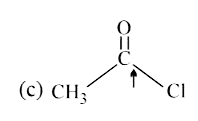name each of the following species and indicate which member of each pair is more stable:
1. CH+3,CH3CH+2
To solve the problem, we need to analyze the two carbocations provided: CH3+ (methyl carbocation) and CH3CH2+ (ethyl carbocation).
Step 1: Identify the species
- The first species CH3+ is called the methyl carbocation.
- The second species CH3CH2+ is called the ethyl carbocation.
Step 2: Analyze the stability of each carbocation
Carbocations are positively charged carbon species that are generally unstable. Their stability can be influenced by the number of alkyl groups attached to the positively charged carbon atom. More alkyl groups typically lead to greater stability due to two main effects:
1. Inductive Effect: Alkyl groups can donate electron density through sigma bonds, which helps to stabilize the positive charge on the carbocation.
2. Hyperconjugation: This is the interaction of the empty p-orbital of the carbocation with adjacent C-H sigma bonds, which helps to disperse the positive charge.
Step 3: Compare the stability
- The methyl carbocation (CH3^+) has no alkyl groups attached to the positively charged carbon. It is a primary carbocation and is less stable due to the lack of stabilizing effects.
- The ethyl carbocation (CH3CH2^+) has one alkyl group (the ethyl group) attached to the positively charged carbon. This provides some stabilization through both inductive effects and hyperconjugation.
Conclusion
Based on the analysis:
- The methyl carbocation is less stable than the ethyl carbocation.
- Therefore, the more stable member of the pair is the ethyl carbocation (CH3CH2^+).
Final Answer
1. Methyl carbocation (CH3^+)
2. Ethyl carbocation (CH3CH2^+)
- More stable member: Ethyl carbocation (CH3CH2^+)
---
- The first species CH3+ is called the methyl carbocation.
- The second species CH3CH2+ is called the ethyl carbocation.
Carbocations are positively charged carbon species that are generally unstable. Their stability can be influenced by the number of alkyl groups attached to the positively charged carbon atom. More alkyl groups typically lead to greater stability due to two main effects:
2. Hyperconjugation: This is the interaction of the empty p-orbital of the carbocation with adjacent C-H sigma bonds, which helps to disperse the positive charge.
- The methyl carbocation (CH3^+) has no alkyl groups attached to the positively charged carbon. It is a primary carbocation and is less stable due to the lack of stabilizing effects.
- The ethyl carbocation (CH3CH2^+) has one alkyl group (the ethyl group) attached to the positively charged carbon. This provides some stabilization through both inductive effects and hyperconjugation.
Based on the analysis:
- The methyl carbocation is less stable than the ethyl carbocation.
- Therefore, the more stable member of the pair is the ethyl carbocation (CH3CH2^+).
1. Methyl carbocation (CH3^+)
2. Ethyl carbocation (CH3CH2^+)
- More stable member: Ethyl carbocation (CH3CH2^+)
Topper's Solved these Questions
- ORGANIC CHEMISTRY: SOME BASIC PRINCIPLES AND TECHNIQUESBOOK - CBSE COMPLEMENTARY MATERIALCHAPTER - ORGANIC CHEMISTRY: SOME BASIC PRINCIPLES AND TECHNIQUESEXERCISE - 2-marks quetion
26 Videos
- ORGANIC CHEMISTRY: SOME BASIC PRINCIPLES AND TECHNIQUESBOOK - CBSE COMPLEMENTARY MATERIALCHAPTER - ORGANIC CHEMISTRY: SOME BASIC PRINCIPLES AND TECHNIQUESEXERCISE - 3 marks question
6 Videos
- ORGANIC CHEMISTRY: SOME BASIC PRINCIPLES AND TECHNIQUESBOOK - CBSE COMPLEMENTARY MATERIALCHAPTER - ORGANIC CHEMISTRY: SOME BASIC PRINCIPLES AND TECHNIQUESEXERCISE - ONE WORD ANSWER TYPE QUESTIONS
10 Videos
- HYDROGENBOOK - CBSE COMPLEMENTARY MATERIALCHAPTER - HYDROGENEXERCISE - Unit Test
11 Videos
- P-BLOCK ELEMENTSBOOK - CBSE COMPLEMENTARY MATERIALCHAPTER - P-BLOCK ELEMENTSEXERCISE - UNIT TEST
8 Videos
Similar Questions
Knowledge Check
In which of the following pairs of carbocations, the first carbocation is more stable than the second ?
(i) CH2=CH−CH2andCH2=CH−CH2−+CH2
(ii) CH3−NH−+CH2and+CH2−OH
(iii) CH3−O−CH2−+CH2andCH3−O−+CH2
(IV) CH3+CH−CH2CH2CH3andCH3CH2−+CH−CH2CH3A(i),(ii) and (iii)B(i) , (ii) and (iv)C(ii) and (iii)D(iii) and (iv)
Expand each of the following condensed formulas into their complete structural formulas.
(a)CH3CH2COCH2CH3
(b)CH3CH=CH(CH2)3CH3
View SolutionIn which of the following pairs, indicated bond is of greater strength :
CH3−CH=CH−↑ Br and CH3−−→C∣BrH−CH3
View SolutionIn which of the following pairs, indicated bond is of greater strength :
 and CH3−CH2−↑ Cl
and CH3−CH2−↑ Cl
View SolutionIn which of the following pairs, indicated bond is of greater strength :
CH2=CH−↑ CH=CH2 and CH2=CH−↑ CH2−CH3
View Solution(a) Draw the structures of major monohola prodcuts in each of the following reactions : 3
(i)
(b) Which halogen compound in each following pairs will react faster in SN2 reaction
(i) CH3Br or CH3I
(ii) CH3C−CI or CH3−CI
View SolutionWhich compound in each of the following pairs will react faster by SN1 reactions in aqueous KOH. Give reasons.
(a) CH3CH2−Br or CH3CH2−Cl
(b) CH3CH2CH2CH2−X or (CH3)3C−X
View SolutionWhich one in each of the following pairs is expected to exhibit hydrogen bonding together ?
(a) CH3−CH2−OHandCH3−O−CH3
(b) CH3NH2andCH3SH
(c ) CH3OCH3and(CH3)3N
View Solution
